NVIDIA’s GeForce GTX 480 and GTX 470: 6 Months Late, Was It Worth the Wait?
by Ryan Smith on March 26, 2010 7:00 PM EST- Posted in
- GPUs
Image Quality & AA
When it comes to image quality, the big news from NVIDIA for Fermi is what NVIDIA has done in terms of anti-aliasing of fake geometry such as billboards. For dealing with such fake geometry, Fermi has several new tricks.
The first is the ability to use coverage samples from CSAA to do additional sampling of billboards that allow Alpha To Coverage sampling to fake anti-alias the fake geometry. With the additional samples afforded by CSAA in this mode, the Fermi can generate additional transparency levels that allow the billboards to better blend in as properly anti-aliased geometry would.
The second change is a new CSAA mode: 32x. 32x is designed to go hand-in-hand with the CSAA Alpha To Coverage changes by generating an additional 8 coverage samples over 16xQ mode for a total of 32 samples and giving a total of 63 possible levels of transparency on fake geometry using Alpha To Coverage.
In practice these first two changes haven’t had the effect we were hoping for. Coming from CES we thought this would greatly improve NVIDIA’s ability to anti-alias fake geometry using cheap multisampling techniques, but apparently Age of Conan is really the only game that greatly benefits from this. The ultimate solution is for more developers of DX10+ applications to enable Alpha To Coverage so that anyone’s MSAA hardware can anti-alias their fake geometry, but we’re not there yet.
So it’s the third and final change that’s the most interesting. NVIDIA has added a new Transparency Supersampling (TrSS) mode for Fermi (ed: and GT240) that picks up where the old one left off. Their previous TrSS mode only worked on DX9 titles, which meant that users had few choices for anti-aliasing fake geometry under DX10 games. This new TrSS mode works under DX10, it’s as simple as that.
So why is this a big deal? Because a lot of DX10 games have bad aliasing of fake geometry, including some very popular ones. Under Crysis in DX10 mode for example you can’t currently anti-alias the foliage, and even brand-new games such as Battlefield: Bad Company 2 suffer from aliasing. NVIDIA’s new TrSS mode fixes all of this.

Bad Company 2 DX11 Without Transparency Supersampling
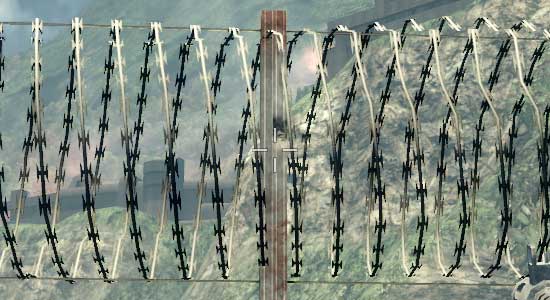
Bad Company 2 DX11 With Transparency Supersampling
The bad news is that it’s not quite complete. Oh as you’ll see in our screenshots it works, but the performance hit is severe. It’s currently super-sampling too much, resulting in massive performance drops. NVIDIA is telling us that this should be fixed next month, at which time the performance hit should be similar to that of the old TrSS mode under DX9. We’ve gone ahead and taken screenshots and benchmarks of the current implementation, but keep in mind that performance should be greatly improving next month.
So with that said, let’s look at the screenshots.

| NVIDIA GeForce GTX 480 | NVIDIA GeForce GTX 285 | ATI Radeon HD 5870 | ATI Radeon HD 4890 |
| 0x | 0x | 0x | 0x |
| 2x | 2x | 2x | 2x |
| 4x | 4x | 4x | 4x |
| 8xQ | 8xQ | 8x | 8x |
| 16xQ | 16xQ | DX9: 4x | DX9: 4x |
| 32x | DX9: 4x | DX9: 4x + AAA | DX9: 4x + AAA |
| 4x + TrSS 4x | DX9: 4x + TrSS | DX9: 4x + SSAA | |
| DX9: 4x | |||
| DX9: 4x + TrSS |
With the exception of NVIDIA’s new TrSS mode, very little has changed. Under DX10 all of the cards produce a very similar image. Furthermore once you reach 4x MSAA, each card producing a near-perfect image. NVIDIA’s new TrSS mode is the only standout for DX10.
We’ve also include a few DX9 shots, although we are in the process of moving away from DX9. This allows us to showcase NVIDIA’s old TrSS mode, along with AMD’s Adapative AA and Super-Sample AA modes. Note how both TrSS and AAA do a solid job of anti-aliasing the foliage, which makes it all the more a shame that they haven’t been available under DX10.
When it comes to performance, keep in mind that both AMD and NVIDIA have been trying to improve their 8x MSAA performance. When we reviewed the Radeon 5870 back in September we found that AMD’s 8x MSAA performance was virtually unchanged, and 6 months later that still holds true. The performance hit moving from 4x MSAA to 8x MSAA on both Radeon cards is roughly 13%. NVIDIA on the other hand took a stiffer penalty under DX10 for the GTX 285, where there it fell by 25%. But now with NVIDIA’s 8x MSAA performance improvements for Fermi, that gap has been closed. The performance penalty for moving to 8x MSAA over 4x MSAA is only 12%, putting it right up there with the Radeon cards in this respect. With the GTX 480, NVIDIA can now do 8x MSAA for as cheap as AMD has been able to
Meanwhile we can see the significant performance hit on the GTX 480 for enabling the new TrSS mode under DX10. If NVIDIA really can improve the performance of this mode to near-DX9 levels, then they are going to have a very interesting AA option on their hands.
Last but not least, there’s anisotropic filtering quality. With the Radeon 5870 we saw AMD implement true angle-independent AF and we’ve been wondering whether we would see this from NVIDIA. The answer is no: NVIDIA’s AF quality remains unchanged from the GTX200 series. In this case that’s not necessarily a bad thing; NVIDIA already had great AF even if it was angle-dependant. More to the point, we have yet to find a game where the difference between AMD and NVIDIA’s AF modes have been noticeable; so technically AMD’s AF modes are better, but it’s not enough that it makes a practical difference
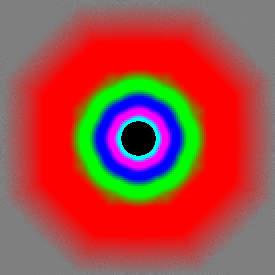
GeForce GTX 480

GeForce GTX 285
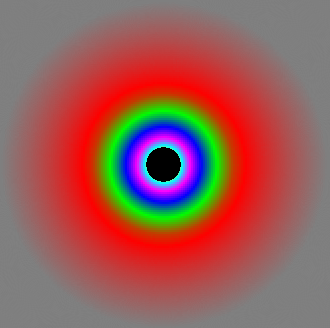
Radeon 5870


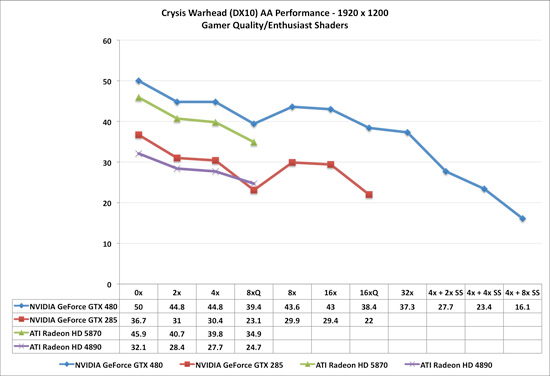
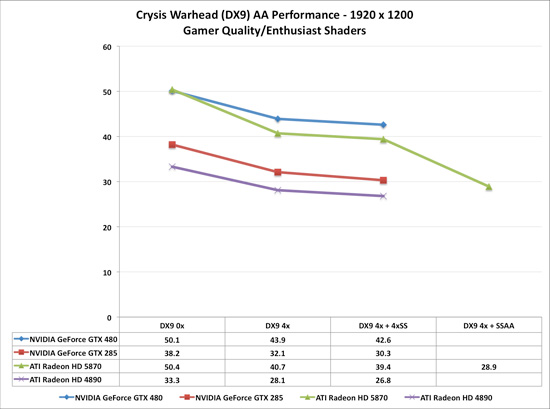








196 Comments
View All Comments
Ryan Smith - Wednesday, March 31, 2010 - link
My master copies are labeled the same, but after looking at the pictures I agree with you; something must have gotten switched. I'll go flip things. Thanks.Wesgoood - Wednesday, March 31, 2010 - link
Correction, Nvidia retained their crown on Anandtech. Even though some resolutions even on here were favored to ATI(mostly the higher ones). On Toms Hardware 5870 pretty much beat GTX 480 from 1900x1200 to 2560x1600, not every time in 1900 but pretty much every single time in 2560.That ...is where the crown is, in the best of the best situations, not ....OMG it beat it in 1680 ...THAT HAS TO BE THE BEST!
Plus the power hungry state of this card is just appauling. Nvidia have shown they can't compete with proper technology, rather having to just cram everything they can onto a chip and prey it works right.
Where as ATI's GPU is designed perfectly to where they have plenty of room to almost double the size of the 5870.
efeman - Wednesday, March 31, 2010 - link
I copied this over from a comment I made on a blog post.I've been with nVidia for the past decade. My brother built his desktop way back when with the Ti 4200, I bought a prefab with a 5950 ultra, my last budget build had an 8600 GTS in it, and I upgraded to the GTX 275 last year. I am in no way a fanboy, nVidia just has treated me very well. If I had made that last decision a few months later after the price hike, it would've definitely been the HD 4890; almost identical performance for ballpark $100 less.
I recently built a new high-end rig (Core i7 and all), but I waited out on dropping the money on a 5800 series card. I knew nVidia's new cards were on the way, and I was excited and willing to wait it out; I expected a lot out of them.
Now that they're are out in the open, I have to say I'm a little shaken. In many cases, the performance of the cards are not where I would've hoped they be (the general consensus seems to be 5-10% increase in performance over their ATI counterparts; I see that failing in many cases, however). It seems like the effort that nVidia put into the cards gave them lots of potential, but most of it is wasted.
"The future of PC gaming" is right in the title of this post, and that's what these cards have been built for. Nvidia has a strong lead over ATI in compute and tessellation performance now, that's obvious; however, that will only provide useful if and when developers decide to put the extra effort into taking advantage of those technologies. Nvidia is gambling right now; it has already given ATI a half-year lead on the DX11 market, and it's pushing cards that won't be fully utilized until who-knows-when (there's no telling when these technologies will be more widely integrated into the gaming market). What will it do in the meantime? ATI is already on it's way to producing its 5000-series refresh; and this time it knows the competition's performance.
I was hoping for the GTX 400s to do the same thing that the GTX 200s did: give nVidia back the high-end performance throne. ATI is not only competitive with it's counterparts, but it still has the 5970 for the enthusiast performance crown (don't forget Eyefinity!). I think nVidia made a mistake in putting so much focus into compute and tessellation performance; it would've been smarter to produce cards with similar die sizes (crappy wafer yields, anyone?), faster raw performance with tessellation/compute as a secondary objective, and more competitive pricing. It wouldn't have been a bad option to create a separate chip for the Tesla cards, one that focused on the compute performance while the GeForce cards focused on the rest.
I still have faith. Maybe nVidia will work wonders with the drivers and producing performance we were waiting for. Maybe it has something awesome brewing deep within its labs. Or maybe my fears will embody themselves, and nVidia is crossing its fingers and hoping for its tessellation/compute performance to give it the market share later on. If so, ATI will provide me with my pair of cards.
That was quite the rant; I wasn't planning on writing that much when I decided to comment on Drew Henry's (nVidia GM) blog post. I suppose I'm passionate about this sort of thing, and I really hope nVidia doesn't lose me after all this time.
Kevinmbaron - Wednesday, March 31, 2010 - link
The fact that this card comes out a year and a 1/2 after the the GTX 295 makes me sick. Add to that the fact that the GTX 295 actually is faster then the GTX 480 in a few benchmarks and very close in others is like a bad dream for nvidia. Forget if they can beat AMD, they can't even beat themselves. They could have did a die shrink on the GTX 295, add some more shadders and double the memory and had that card out a year ago and it would have crushed anything on the market. Instead they risked it all on a hair brained new card. I am a GTX 295 owner. Apperently my card is a all arround better card being it doesnt lag in some games like the 480 does. I guess i will stick with my old GTX 295 for another year. Maybe then there might be a card worth buying. Even the ATI 5970 doesn't have enough juice to justify a new purchase from me. This should be considered horrible news for Nvidia. They should be ashammed of themselves and the CEO should be asked to step down.ol1bit - Thursday, April 1, 2010 - link
I just snagged a 5870 gen 2 I think (XFX) from NewEgg.They have been hard to find in stock, and they are out again.
I think many were waiting to see if the GF100 was a cruel joke or not. I am sorry for Nivida, but love the completion. I hope Nvidia will survive.
I'll bet they are burning the midnight oil for gen 2 of the GF100.
bala_gamer - Friday, April 2, 2010 - link
Did you guys recieve the GTX480 earlier than other reviewers? There were 17 cards tested on 3 drivers and i am assuming tests were done multiple times per game to get an average. installing, reinstalling drivers, etc 10.3 catalyst drivers came out week of march 18.Do you guys have multiple computers benchmarking at the same time? I just cannot imagine how the tests were all done within the time frame.
Ryan Smith - Sunday, April 4, 2010 - link
Our cards arrived on Friday the 19th, and in reality we didn't start real benchmarking until Saturday. So all of that was done in roughly a 5 day span. In true AnandTech tradition, there wasn't much sleep to be had that week. ;-)mrbig1225 - Tuesday, April 6, 2010 - link
I felt compelled to say a few things about nvidia’s Fermi (480/470 GTX). I like to always start out by saying…let’s take the fanboyism out of the equation and look at the facts. I am a huge nvidia fan, however they dropped the ball big time. They are selling people on ONE aspect of DX11 (tessellation) and that’s really the only thing there cards does well but it’s not an efficient design. What people aren’t looking at is that their tessellation is done by the polymorh engine which ties directly into the cuda cores, meaning the more cuda cores occupied by shaders processing…etc the less tessellation performance and vice versa = less frames per sec. As you noticed we see tons of tessellation benchmarks that show the gtx 480 is substantially faster at tessellation, I agree when the conditions suite that type of architecture (and there isn’t a lot of other things going on). We know that the gf100(480/470gtx) is a computing beast, but I don’t believe that will equate to overall gaming performance. The facts are this gpu is huge (3billion + transistors), creates a boat load of heat, and sucks up more power than any of the latest dual gpu cards (295gtx, 5970) came to market 6 months late and is only faster than its single gpu competition by 10-15% and some of us are happy? Oh that’s right it will be faster in the future when dx11 is relevant…I don’t think so for a few reasons but ill name two. If you look at the current crop of dx11 games, the benchmarks and actual dx11 game benchmarks (shaders and tessellation…etc) shows something completely different. I think if tessellation was nvidia’s trump card in games then basically the 5800 series would be beat substantially in any dx11 title with tessellation turned on…we aren’t seeing that(we are seeing the opposite in some circumstances), I don’t think we will. I also am fully aware that tessellation is scalable, but that brings me to another point. I know many of you will say that it is only in extreme tessellation environments that we really start to see the nvidias card take off. Well if you agree with that statement then you will see that nvidia has another issue. The 1st is the way they implement tessellation in their cards (not very scalable imo) 2nd is, the video card industry sales are not comprised of high end gpus, but the cheaper mainstream ones. Since nvidia polymorph engine is tied directly to its shaders…u kinda see where this is going, basicly less powerful cards will be bottlenecked by their lack of shaders for tessellation and vice versa. Developers want to make money, the way they make money is selling lots of games, example crysis was a big game, however it didn’t break any records sales…truth of the matter is most people systems couldn’t run crysis. Now you look at valve software and a lot of their titles sale well because of how friendly it is to mainstream gpus(not the only thing but it does help). The hardware has to be there to support a large # of game sales, meaning that if the majority of parts cannot do extreme levels of tessellation then you will find few games to implement it. Food for thought… can anyone show me a dx11 title that the gtx480 handily beats the 5870 by the same amount that it does in the heaven benchmark or even close to that. I think as a few of you have said, it will come down to what game work better with what architecture..some will benefit nvidia(Farcry2..good example) others Ati (Stalker)…I think that is what we are seeing now. IMOP.S. I think also why people are pissed is because this card was stated to be 60% faster than the 5870. As u can see its not!!
houkouonchi - Thursday, April 8, 2010 - link
Why the hell are the screenshots showing off the AA results in a lossy JPEG format instead of PNG like pretty much anything else?dzmcm - Monday, April 12, 2010 - link
I'm not familiar with Battleforge firsthand, but I understood it uses HD Ambient Occlusion wich is a variation of Screen Space Ambient Occlusion that includes normal maps. And since it's inception in Crysis SSAO has stood for Screen Space AO. So why is it called Self Shadow AO in this article?Bit-tech refers to Stalker:CoP's SSAO as "Soft Shadow." That I'm willing to dismiss. But I think they're wrong.
Am I'm falling behind with my jargon, or are you guys not bothering to keep up?